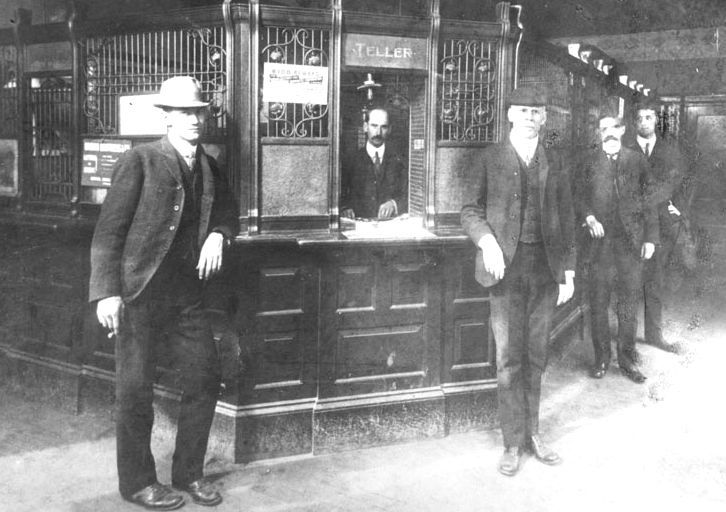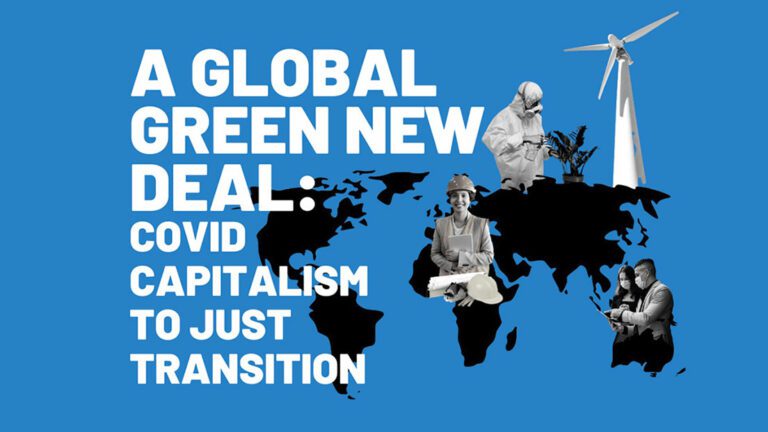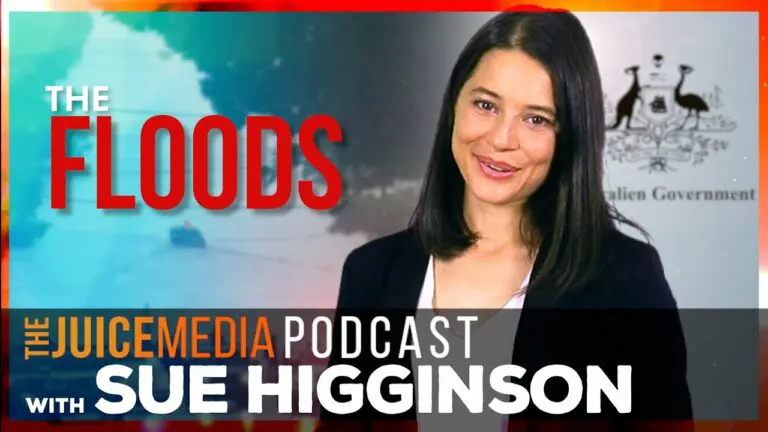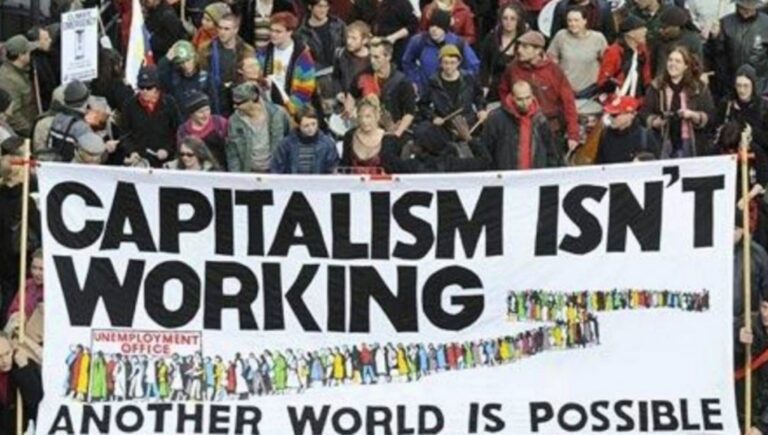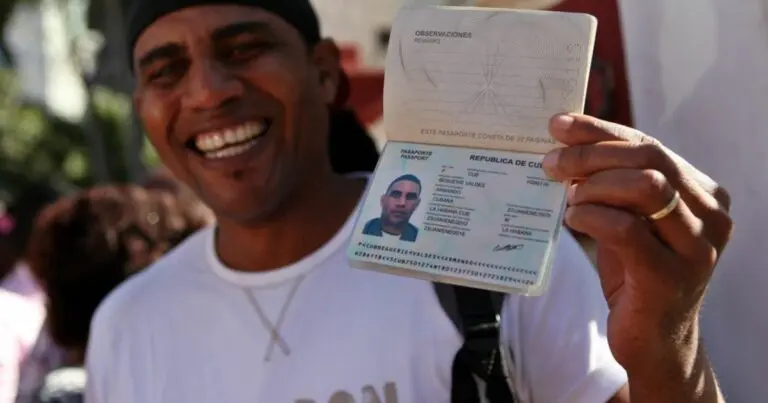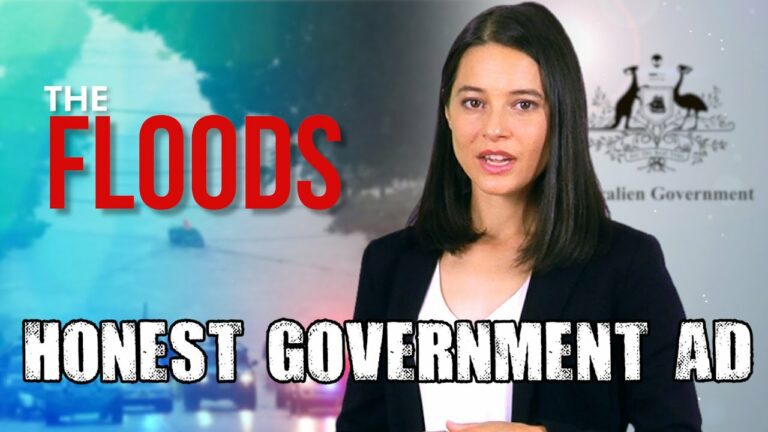This interview was originally released on April 28, 2017. The Next System Project’s Gar Alperovitz tells Paul Jay that the Federal Reserve should use quantitive easing, i.e. create money, to take Big Oil companies out of the equation and finance a massive green infrastructure program.
PAUL JAY: Welcome to The Real News Network, and welcome to Reality Asserts Itself. I’m Paul Jay. On April 29th, cities around the world are going to be witnessing marches, and rallies about climate change. And the issue is rather urgent. There is an administration in Washington that does not believe in human-caused climate change. According to a Yale survey, while over 70% of Americans believe in global warming, only 53% of those Americans actually think it’s human-caused. When you talk to people who don’t think it’s human-caused, and why you think climate deniers are legitimate, you often hear, well, it’s just big government. They just want to tax us. Which is clearly messaging coming directly from the Koch brothers’ machine. Only 16% of people in the Yale survey thought that climate change would directly affect them, or their families. You have an enormous gap between scientific knowledge, scientific consensus, and public opinion, or a great deal of American public opinion, at least. What comes next? Well, one, there is a battle over public opinion. But part of that battle over public opinion is many people suggest that dealing with climate change is just overwhelming. I can’t tell you how many people who do believe in human-caused climate change tell me, “I just can’t think about it. Because there’s nothing we can do about it. There’s no vision of what a solution really actually looks like.” Well, that’s what the interview today is about. What might a green, sustainable economy look like? What are some measures that could be taken in an urgent, and rather quick way, if in fact, you had people in political office with real political power, and who actually were willing to deal with the crisis? Now, joining us in the studio once again is Gar Alperovitz. Thanks very much for joining us.
GAR ALPEROVITZ: Thanks for having me.
PAUL JAY: Gar Alperovitz is the co-founder of the Democracy Collaborative, and founder and co-chair of the Next Systems Project. Previously, he was a top political economist, University of Maryland. He’s the author of many books, including the forthcoming, “Principles of a Pluralist Commonwealth”. Thanks for joining us.
GAR ALPEROVITZ: Good to be here.
PAUL JAY: Millions of people, perhaps, might demonstrate on the 29th. But honestly, it’s actually a small fraction of the public that sees this as an urgent issue. It was barely mentioned in the last presidential election. Bernie Sanders certainly raised it several times. And when asked once what’s the most urgent national security problem, he said, “climate change.” When it came to Hillary Clinton, versus Donald Trump, of course Trump is a denier, and Hillary barely raised it. But even President Obama, during most of his years in office, barely mentioned it. So, it’s very low on the political agenda. I think one of the reasons for this, as I just mentioned, is that people don’t see what you could do about it anyway, so better put it out of your mind. First of all, talk a bit about the political crisis right now in the United States, and the fact how do you get climate deniers elected? And then we’ll talk a little bit about what a vision for a solution might look like.
GAR ALPEROVITZ: Well, it’s pretty easy to understand how you get climate deniers elected. As in, a lot of money from the oil companies, and the Koch brothers, and the coal companies, really want to keep these people in office, and keep their hands off of the pollution that climate change is involved with. So, we can see where the money’s coming from, and we can see where the public interest is. Then we can see where the special interest is. You know, there are lots of reasons why Trump got elected. But one of them, there was a lot of money from those interests who knew that he was on their side. And he’s appointed people to the Environmental Protection Agency, is in the hands of people who want to rip it apart. The Energy… the Interior Department’s in the hands of a governor of Texas who was an oil baron governor. The power structure currently is denying all of this. The Secretary of State was an Exxon president; the whole structure is the oil companies and the people who sponsored them. That doesn’t mean that lasts forever. I mean, I’m a political… I’m involved in politics; I’m involved in political economy. I’m a historian of this. You know, things have a way of changing when people begin to get angry. And the Bernie movement showed that there’s something else out there, that can be mobilized, and needs to be mobilized, in a much more powerful way — building on what’s already been done.
PAUL JAY: So, if you were advising Bernie, or a Bernie-type candidate, in 2020, if such a candidate actually was elected president, and probably in an environment where if there was such a breakthrough –- you can’t rule it out -– but likely dealing with a Congress that is probably not going to be all that collaborative, and a media that will probably be very antagonistic, and certainly a financial world that will be trying to crash down your house. At the same time, given all of that, facing such an existential threat of climate change, what would you recommend? What is a kind of vision for what that policy looks like?
GAR ALPEROVITZ: Well, again, I’m a long-time optimist, but I’ve also been involved in activist politics. The opposition, for instance, to the Vietnam War didn’t exist, and three years later, it was ready to elect the presidents. The same kind of opposition built up. We could easily have elected Bernie this time. I think that was well within the possibility. People underestimate the possibilities of politics, because we haven’t seen it done. I think we’re in a changing mood about that, and particularly if the Trump administration continues to flounder, and the pain levels of ordinary families go up, we’re going to see a different kind of politics -– possibly. So, I don’t rule out major political shifts again, a big change. But beyond that, there’s obviously the people who know a lot about what ought to be done on the ground. There’s a lot… just insulating houses is the number one thing. Moving to wind power, and moving to solar power. There’s a huge range of things that can be done right now, and are being done. But the big problem is political. It’s getting the oil companies, and what’s left of the coal companies, out of the way, so you can actually mobilize to do the things that need to be done. And that’s where the problem is politically, that they put a lot of money into stopping even minor kinds of regulatory processes that were proposed by the Obama administration -– they stopped them.
PAUL JAY: There’s barely more than a handful of people in Congress that don’t get Koch money, and Koch brothers money, one way or the other — in both parties.
GAR ALPEROVITZ: In both parties… A lot of pressure, and a lot of money, could go into the oppositions. Even if you don’t get money, you’ve got to cool it. I mean, you really do need to cool it, in a different sense of the word. So, they are the ones that have been stopping any serious kind of activity to deal with climate change. And so, that’s where the big problem is. And unless we address that, then we’re running out of time. I mean, most of the people studying this to get to the limits of global warming before which we start getting into real, real problems, 2 degrees centigrade is the usual number, but it’s in that range. We’ve got three or four, maybe five years -– that’s what most of the studies say -– we’re now at an interval of time that’s really urgent. So, it’s an important moment to begin saying, let’s get serious about this, and what could you do if you got serious?
PAUL JAY: So, let’s imagine 2020. A Sanders-esque, or Sanders himself, type candidate, actually gets elected. What do you do? What are some of the big ideas of what you do?
GAR ALPEROVITZ: Well, some of the big ideas that have been developing, we’ve been working on this with other people around the country, and you have to think about this: how do we build power and understanding over the next two or three years, so we can actually do something, hopefully when there’s a new president? But you’ve got to build the understanding. One of them is called the quantitative easing for climate change. Now what in the world does that mean? What it means is, that’s a term that bankers use, and it’s a term the Federal Reserve Board uses all the time, and they’ve done $2 trillion of making new money available for the banks when they needed it. People don’t really understand that the Federal Reserve Board creates money. That’s what it does. Otherwise, we’d have an economy that could never get bigger than what it is. There’s got to be an expanding source of money, so the economy can grow. They did it to bail out the banks, and very large amounts of money were created — $2 to $3 trillion.
PAUL JAY: Because the assets were considered so toxic. A bunch of sub-prime mortgage properties, and mortgages that were worthless, they had to make the banks books look like they were still solid.
GAR ALPEROVITZ: Yes. And they also wanted to finance a development process, so the economy could grow, but the techniques are common sense, all bankers know it. The European bankers have been doing it for years –- they’re still doing it now. The Japanese bankers are doing it. The Federal Reserve Board has to create money literally out of nothing, or the economy would never be able to grow. So, that’s well understood by financial experts. To most citizens, it seems like magic. But indeed, that’s the way banks work.
PAUL JAY: We’ll get into that a little bit more in a second, but then what do you do going to do with the money?
GAR ALPEROVITZ: Well, that’s what’s interesting. Because if you use the common techniques –- they call it quantitative easing –- if you use those techniques, you could create sufficient funds, essentially, to buy out the oil companies and nationalize them. And to create that kind of a fund, and get them out of the way politically, for doing what has to be done on climate change, urgently. Because they are the major blocking power that’s stopped us from doing all the solar insulation, and doing all the solar development, wind development, insulation in general. There’s a whole series of things we know ought to be done — and stopping using fossil fuels.
PAUL JAY: Basically, you’re talking about buying out the Koch brothers, Mobil…
GAR ALPEROVITZ: Yes, and Exxon, and the big companies.
PAUL JAY: Some of the biggest fortunes in the world.
GAR ALPEROVITZ: Yes. And they are, interestingly, they are under pressure, from people like the Securities and Exchange Commission. Why? Because they see -– the Securities and Exchange Commission –- see that, over time, the pressure is building up on these companies, which means that the value of the oil they’ve got in the ground is shaky. Their books are reflecting numbers that may not reflect the numbers they would like to say it’s worth all this money. Maybe not — if you say this is a movement that’s building anyway, it’s beginning to cut into your shaky assets. They may very well find a buyout favorable.
PAUL JAY: Movement meaning… movement meaning, the pressure because of climate change…
GAR ALPEROVITZ: Yes.
PAUL JAY: …is putting a limit on just how long this fossil fuel economy can keep going, and that means your reserves that you might have thought are good for 30, 50, 75 years. In a much shorter timeframe, may be regulated in some other way out of business. So, you may want to get out when the getting is good, is the theory.
GAR ALPEROVITZ: That’s exactly right. That they understand –- and it’s not only they –- but when you’ve got the regulators, the Securities and Exchange Commission saying, “Hey, you’re not reflecting this in your books, and that’s illegal, because you’ve got to tell the truth to your stockholders.” The value of your underlying assets, because there is a building climate change movement, there’s a shakiness about that. And you can’t go honestly to the stock market and say; it’s worth X, when it may not be worth X. So, there’s some pressure on them, as well, from their boards and from the stockholders. So, they may very well be happy to be bought out –- or not happy, or at least not as resistant as you might expect. And then the question becomes how do you finance it? And what’s really important again is…
PAUL JAY: Before we get to finance it, you’re likely to have a war with the Koch brothers. The Koch brothers… I would say this is everything the Koch… when the Koch brothers go to sleep and have a nightmare…
GAR ALPEROVITZ: (laughs)
PAUL JAY: …the idea of a government being able to come in and take them over, even if they get paid for it, this is socialism. This is everything they spend so much money fighting against.
GAR ALPEROVITZ: Well, there’s the divide and conquer part of this, as well. The Koch brothers may be the last ones to fall, but Exxon might go down earlier. Why? Because they’re not… their stock… they’re listed on the stock marke,t and that’s a big deal. As we were saying, it’s…
PAUL JAY: Yeah. And you just go buy the stock.
GAR ALPEROVITZ: Yeah. Just buy it out. So, it sounds… to most people who’ve not been studying what’s already going on, as conventional in the banking industry. What happens all the time in this country and other… creating money to buy assets, this is a step beyond that. But it’s not using techniques that are not well known all over the world, to the people who specialize in this. They call it quantitative easing. But we call it quantitative easing, not for the banks, but for the planet.
PAUL JAY: Okay. So, let’s say, in 2020, the message gets through to American public opinion that we’re facing an existential crisis.
GAR ALPEROVITZ: Right.
PAUL JAY: There’s a mood in the country. This has to be done quickly. We know that one of the recent studies shows that the 2 percent threshold -– not 2 percent, 2-degree threshold, in terms of warming, which is considered this threshold that if you cross, it’s very hard to come back. One of the studies, Sir Robert Watson, was the head of, former chair of the IPCC, said that if all the countries that pledged to do everything they… if they actually did everything they pledged to do at the Paris Agreement, we’d still hit the 2- degree threshold by 2050. And that’s before Trump gets elected. So, let’s say the mood in the country gets the existential threat, you actually have this kind of progressive elected. So, then let’s get into… so now you use… and quantitative easing, explain the mechanism, and part of that mechanism is, you don’t need Congress to do it.
GAR ALPEROVITZ: Right. You don’t need Congress to do it. There’s a question in the 4th Circuit right now, as to exactly what powers, and emergency powers, the Federal Reserve Board has. They did do this for the big banks, at very large scale, so that has to be resolved. You may need Congress, or you may not need Congress to do this. Just depending…
PAUL JAY: You probably would at least need the Senate in order to confirm a head of the Federal Reserve that would buy into this.
GAR ALPEROVITZ: Yes, and I hope the… there is a big political problem, but the crisis is also building. And the question is whether people begin to demand something beyond the usual things we’ve been talking about in climate change, which are not getting us to deal with the trends. So, we’ve been… we’ve discovered, that as people think about this idea which comes out as a little bit odd at first, and because people don’t know about banking, and they begin to think about it, what could you do to actually change the trend? What could you do? We’ve got to do solar, we’ve got to do insulation, we’ve got to do wind. All the things we know about. But they’re slow. If we really are facing a four-year window, if that’s… you know, and that’s kind of the current estimate, then you’ve got to do something bold. And what we’re talking about, is something using these well-known techniques, and going in and taking these guys out. Or buying up 50%, if you like, and then the other people are going to get out as fast as they can, so there may be faster ways to do it.
PAUL JAY: So, again, just to retrace what would happen in quantitative easing, one of the techniques at any rate is the government issues. For example, bonds, T-bills. The Fed buys them, and then this money now… the government now has, and goes and buys the oil companies.
GAR ALPEROVITZ: Yes. That’s one…
PAUL JAY: Then takes them out politically, as well as changes their mission.
GAR ALPEROVITZ: And that’s really the goal. I mean, this is something that’s been done, not only for the banks, this is how Lincoln financed the transcontinental railroad, essentially. He created money this way. It was done by Roosevelt with the RFC. The Refinancing Corporation, which also created money for industrial redevelopment. This is not unusual. It’s just unusual for most people who don’t know how banking works. But it would be for a special targeted reason to move fast. Because we’ve got a crisis, and to move in, and getting the political opposition out of the way, and doing the job.
PAUL JAY: Okay. One of the main critiques of this kind of quantitative easing, because this idea has been around for a while, which applying it to oil companies is new, but the idea of using it to fund jobs, or fund infrastructure, that’s been around for a while. And I guess the main critique of it is that it’s essentially inflationary. You can’t just make up so much money, put it into the economy, without debasing the currency that’s there. So, how do you respond to that?
GAR ALPEROVITZ: Well, the inflation argument is… there is a monetary theory about that, but the first inflationary argument is that there’s not enough productive capacity to build up… you run into price increases, because people would be more money than you could create houses, or cars, or equipment of all kinds, all the things people need. There’s a lot of unemployment in this economy. If you measured it the proper way, it’s probably 10% or 11%. And certainly, in the black community, it’s probably double that. It’s not measured properly in the statistics. But so, the idea that we’re at a limit of productive capacity where prices have to go up, is almost certainly wrong. Now, the oil companies might very well say, “well, we’ll sell out to you, but here’s the price of the stock”, and try to boost the stock. One way around that probably is to say, well, we’re going to buy only 51%. Do you want to be bought now or later? There’d probably be a rush to the exits if you did that. So, there are techniques that basically are involved…
PAUL JAY: Back up one step with the sort of this issue of is it inflationary or not. What I’ve heard of the theory previously is that the sort of mitigation of the amount you can quantitatively ease, the amount of money you can just create – and put into infrastructure or put into buying out oil companies – the measure of that is unemployment. That you can keep doing it until unemployment reaches full employment. Of course, there’s a big debate what full employment is. But if you get down to 1% or 2% real unemployment, I suppose that’s gauging on full, then at that point you stop doing it. As long as you keep that balance, it’s not inflationary.
GAR ALPEROVITZ: Exactly.
PAUL JAY: Now, the counter-argument to that is you can’t control it so easily. This isn’t a tap you can just turn on and off. That once you start a process like that, and I believe that’s what people that own bonds, and own assets, and are afraid of inflation so much because it’s going to decrease the value of their assets, they think you let the genie out of the bottle, you can’t put it back in again.
GAR ALPEROVITZ: Well, I think that we’re at a place where the unemployment rate, if you measured it properly, is much higher than most people think. We’re not near full capacity. Now, there is an argument… the bankers will make the argument, the kind you’re talking about, but I think it’s way, way overblown. The other piece is, what you’re likely to see is this is going to, quote, “rich people”. They would be bought out. And probably what they’re going to do is not go out and buy houses, lots more houses of the kind that ordinary working people want, they’re not going to buy a whole lot more… they’re probably going to have to invest it in bonds or stocks elsewhere…
PAUL JAY: Go gamble with it.
GAR ALPEROVITZ: …or go gamble with it, or yachts.
PAUL JAY: Derivatives plays, whatever. Yeah.
GAR ALPEROVITZ: Yeah. This is not injecting directly into the ordinary buying stream.
PAUL JAY: Yeah. When you’re doing it for buying out oil companies, it just… the people that own… I mean, ordinary shareholders will get bought out. And some of that will hit, but the big players, they have mountains of cash they’re sitting on and this goes on top of their mountains of cash.
GAR ALPEROVITZ: Exactly. So, the two arguments…
PAUL JAY: So, it’s not so inflationary.
GAR ALPEROVITZ: That’s… the two arguments about the inflation, one is just the one you’ve said, that the owners of the stock are not people who are being restricted in their current purchases. They’ll put it into something…
PAUL JAY: The big ones.
GAR ALPEROVITZ: …the big ones.
PAUL JAY: Just small. A lot of people… ordinary people have it, but I guess it’s not…
GAR ALPEROVITZ: It’s a small percentage.
PAUL JAY: …significant numbers, yeah.
GAR ALPEROVITZ: Yeah. So that, yes… that’s… so that’s not likely to be inflationary. And given the under-utilization of capacity; both of working people, lots of unemployment, factories that are not at full capacity, we’re not likely to see the kind of inflation that you would expect if you put it in the hands of people buying things every day.
PAUL JAY: And I guess we’ve just seen this. Trillions of dollars was already involved in the Fed giving money to the banks, so we’ve seen this quantitative easement happen, and it wasn’t inflationary.
GAR ALPEROVITZ: Exactly.
PAUL JAY: Because it went to big players who don’t go out and buy lots of stuff.
GAR ALPEROVITZ: Exactly. That’s just what happened with the big banks, and of the same orders of magnitude: trillions of dollars went into quantitative easing for the banks. This is quantitative easing for the climate. But it does… goes back into the banks and sits there, unless there’s good investment opportunities…
PAUL JAY: Okay. So, let’s say this works. Now you’ve taken the majority of the fossil fuel companies out, probably the Koch brothers are still there trying to shoot you, and find new ways to fight this. But at any rate, you’ve eliminated a lot of the political opposition. You’re able to actually change the mission of some of the big oil companies, and convert them either into green sustainable economy-type things, but that is the next step.
GAR ALPEROVITZ: Right.
PAUL JAY: There needs to be a vision for how you actually get to a green, sustainable economy. And part of that is that market forces alone aren’t going to do it. Market forces alone are doing what they’re doing. They don’t want to go away from a fossil fuel economy. There was some attempt in ’07-’08, there was a lot of talk about how Wall Street was going to get in on the greening of the economy, there was money to be made there. But the market asserted itself in quite a contrary way, and climate change, and green economy, even though in some areas it’s starting to become more than competitive with fossil fuel. It is still certainly not the dominant discourse, but then what does the plan look like when you are going to be in a big fight with a lot of the private sector?
GAR ALPEROVITZ: Well, I think what’s happening is technology is moving very much fast and in favor of what we’re trying to do. Solar is moving… the cost of solar installation has gone radically down over the last 15 years. I mean, there are extraordinary changes. Solar is competitive with almost anything now in most parts of the country. And in some parts of the country, really more than competitive with those big, big solar arrays. Wind has developed in the same way. That’s the secondary. And insulation of housing – all these things are developing very quickly. And they pay off. I mean, there’s a payoff if you can insulate your house and save on the bills of heating the house, et cetera. Automobiles are moving in the same way. Electric cars and, again, charging them with different ways of getting solar energy into the charging systems. This is moving… the technology is moving very fast, and investments in it are the other part of this. Part of the money could be put into a bank to invest in this sort of thing, that we could have a reinvestment. We know a lot about that side of the equation. The part we haven’t been able to get a hold of is how to stop the people who are blocking current production of CO2, and throwing it into the atmosphere.
PAUL JAY: In the next segment of our interview, we’ll talk about the other sector of the political economy, that you will be fighting to the death, and that’s Wall Street finance, because it’s not just fossil fuel that isn’t going to like this. Finance ain’t gonna be very happy, either. So, please join us for Part 2 of my interview with Gar Alperovitz.
Never miss another story
Subscribe to theAnalysis.news – Newsletter
“Gar Alperovitz is an American historian and political economist. Alperovitz served as a fellow of King’s College, Cambridge; a founding fellow of the Harvard Institute of Politics; a founding Fellow at the Institute for Policy Studies; a guest scholar at the Brookings Institution; and the Lionel R. Bauman Professor of Political Economy at the University of Maryland Department of Government and Politics from 1999 to 2015. He also served as a legislative director in the US House of Representatives and the US Senate and as a special assistant in the US Department of State.”



